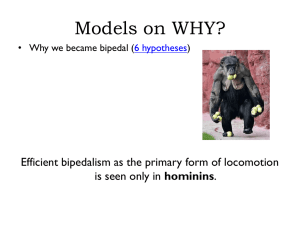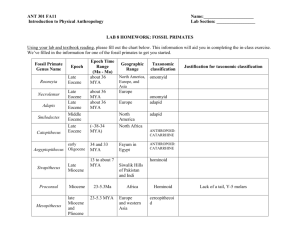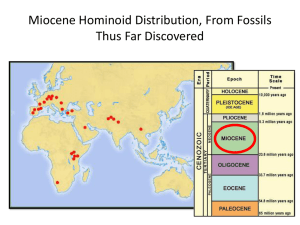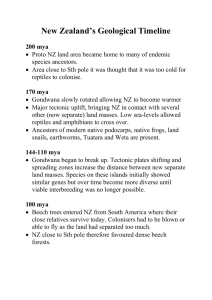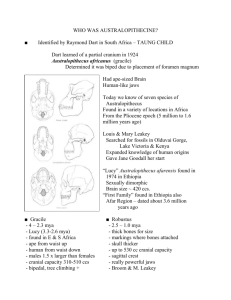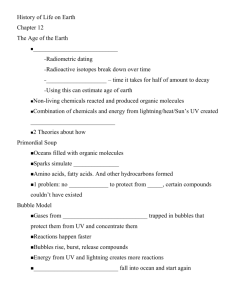Chapter 9 Hominin Origins Early Primate Evolution 1 I need to make
advertisement
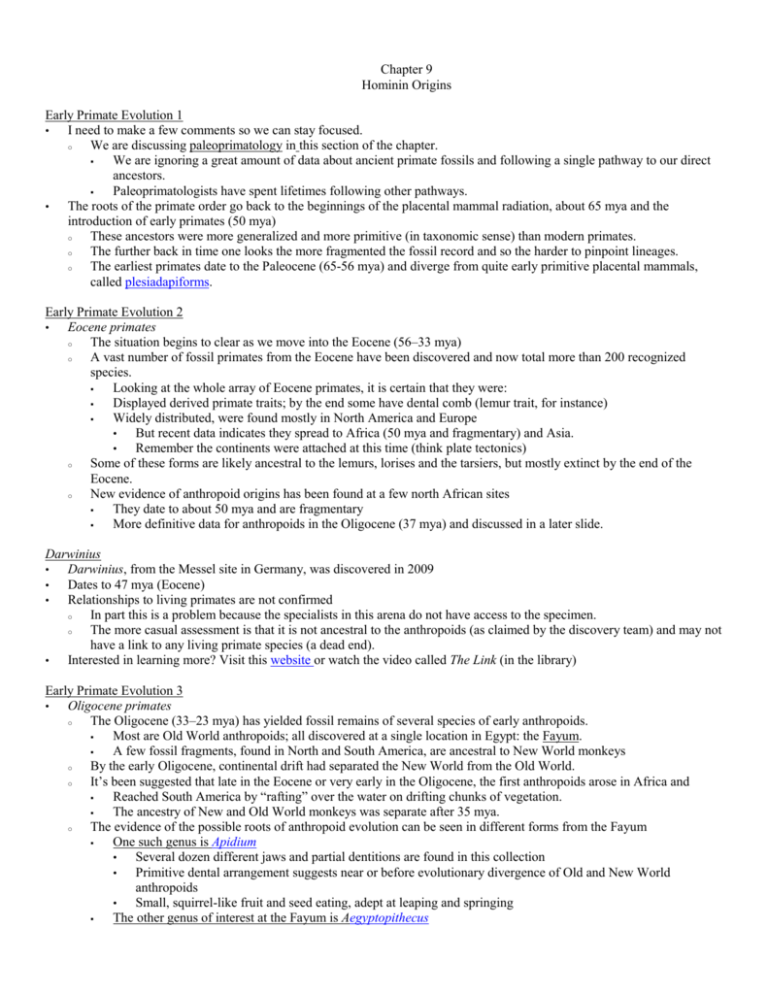
Chapter 9 Hominin Origins Early Primate Evolution 1 • I need to make a few comments so we can stay focused. o We are discussing paleoprimatology in this section of the chapter. We are ignoring a great amount of data about ancient primate fossils and following a single pathway to our direct ancestors. Paleoprimatologists have spent lifetimes following other pathways. • The roots of the primate order go back to the beginnings of the placental mammal radiation, about 65 mya and the introduction of early primates (50 mya) o These ancestors were more generalized and more primitive (in taxonomic sense) than modern primates. o The further back in time one looks the more fragmented the fossil record and so the harder to pinpoint lineages. o The earliest primates date to the Paleocene (65-56 mya) and diverge from quite early primitive placental mammals, called plesiadapiforms. Early Primate Evolution 2 • Eocene primates o The situation begins to clear as we move into the Eocene (56–33 mya) o A vast number of fossil primates from the Eocene have been discovered and now total more than 200 recognized species. Looking at the whole array of Eocene primates, it is certain that they were: Displayed derived primate traits; by the end some have dental comb (lemur trait, for instance) Widely distributed, were found mostly in North America and Europe • But recent data indicates they spread to Africa (50 mya and fragmentary) and Asia. • Remember the continents were attached at this time (think plate tectonics) o Some of these forms are likely ancestral to the lemurs, lorises and the tarsiers, but mostly extinct by the end of the Eocene. o New evidence of anthropoid origins has been found at a few north African sites They date to about 50 mya and are fragmentary More definitive data for anthropoids in the Oligocene (37 mya) and discussed in a later slide. Darwinius • Darwinius, from the Messel site in Germany, was discovered in 2009 • Dates to 47 mya (Eocene) • Relationships to living primates are not confirmed o In part this is a problem because the specialists in this arena do not have access to the specimen. o The more casual assessment is that it is not ancestral to the anthropoids (as claimed by the discovery team) and may not have a link to any living primate species (a dead end). • Interested in learning more? Visit this website or watch the video called The Link (in the library) Early Primate Evolution 3 • Oligocene primates o The Oligocene (33–23 mya) has yielded fossil remains of several species of early anthropoids. Most are Old World anthropoids; all discovered at a single location in Egypt: the Fayum. A few fossil fragments, found in North and South America, are ancestral to New World monkeys o By the early Oligocene, continental drift had separated the New World from the Old World. o It’s been suggested that late in the Eocene or very early in the Oligocene, the first anthropoids arose in Africa and Reached South America by “rafting” over the water on drifting chunks of vegetation. The ancestry of New and Old World monkeys was separate after 35 mya. o The evidence of the possible roots of anthropoid evolution can be seen in different forms from the Fayum One such genus is Apidium • Several dozen different jaws and partial dentitions are found in this collection • Primitive dental arrangement suggests near or before evolutionary divergence of Old and New World anthropoids • Small, squirrel-like fruit and seed eating, adept at leaping and springing The other genus of interest at the Fayum is Aegyptopithecus • • • • Known from several crania and an abundance of jaws and teeth. Largest of Fayum anthropoids, roughly the size of a modern howler monkey (13-18 lbs) Likely was a slow-moving, short-limbed monkey Bridges the gap between Eocene fossils and succeeding Miocene hominoids. Even so it is a very primitive OW anthropoid The Cenozoic Miocene Fossil Hominoids 1 • During the 18 million years of the Miocene (23-5 mya) a great deal of evolutionary activity took place. o In Africa, Asia, and Europe, the diverse and highly successful hominoids emerged. There were many more hominoid forms during this time than there are now! Some call this the ‘golden age’ of the hominoids. o Thousands of fossils have been found from dozens of sites in East Africa, southwest Asia, western and southern Europe, and China. • During the Miocene, the climate transformed as the landmasses repositioned. o By 23 mya, major continental locations were quite similar to those we see today. Even so South and North Americas were separated. The Southern Plate had created the Himalayas South America & Australia had continued to migrate away from Antarctica o The result was that the Miocene epoch was considerably warmer than it had been in the Oligocene. o Also, by 16 mya, the Arabian Plate had docked with northeastern Africa. Soon after 16 mya, African hominoids migrated out and colonized Asia Later, Europe. Miocene Fossil Hominoids 2 • The “$64,000 question” is which of these Miocene fossils is our ancestor? o We do not know. o In part because there were so many and in part it remains hard to interpret. • For now, it may be best to group the Miocene hominoids geographically: o African forms (23–14 mya) Especially from western Kenya, these include quite generalized and primitive hominoids. The best known example is Proconsul • Postcranially more like a monkey than an ape • There are derived traits in the teeth that link Proconsul to the apes, though o Recently, Namibia has been the site of additional fossil finds Miocene Fossil Hominoids 3 • European forms (16–11 mya) o Known from widely scattered localities in France, Spain, Italy, Greece, Austria, Germany, and Hungary, most of these forms are quite derived o The best known is the genus Dryopithecus o The Hungarian and Greek fossils are usually assigned to different genera (including Ouranopithecus for the Greek specimens) o Suggestion of a link to the ape/hominins of Africa but most now think these similarities to apes is due to homoplasy • Asian forms (15-5 mya) o The largest and most varied group of Miocene hominoids, they are dispersed from Turkey through India and Pakistan to southern China. o The best known is Sivapithecus o Most of these specimens are highly derived Miocene Fossil Hominoids 4 115_Chapter 9 Page 2 • • While the Miocene hominoid fossils are 1) widely distributed, 2) are numerous, 3) span a significant part of the Miocene, 4) they are poorly understood. We can draw some general conclusions: o These are hominoids; they’re more closely related to the ape-human lineage than to Old World monkeys. They are large-bodied hominoids (including the great apes (orangutans, chimpanzees, gorillas), hominins, and ancestral forms): they’re more similar to the lineages of orangutans, gorillas, chimpanzees, and humans. Most of the forms thus far discovered are so derived that they’re probably not ancestral to any living form. o The form Sivapithecus from Turkey and Pakistan shows highly derived facial features similar to the modern orangutan, suggesting a fairly close evolutionary link. o Evidence of definite hominins from the Miocene has not yet been indisputably confirmed. Finds from Kenya, Ethiopia, and Chad (7-6 mya) suggest that hominins diverged in the later Miocene. Newest evidence shows that the divergence of closer apes from the hominin line, in the late Miocene may have dated 10-7 mya. What’s a Hominin? • Name for members of tribe Hominini and refers to all great apes (orangutans, gorillas, chimpanzees, and bonobos) and humans. See Figure 9.8 (p. 204) o Hominin is the term for members of the family Homininae, which includes all bipedal hominoids back to the divergence from African great apes o We know (now) that chimpanzees and bonobos are more closely related to us than to other apes. o The term hominid (which I used for decades) to mean our direct lineage is now being used for all great apes and human. • The earliest hominins (so far) have been traced to the end of the Miocene, and consist of dental and cranial pieces and demonstrate that mosaic evolution of hominin traits was the norm o Mosaic evolution is defined as a pattern of evolution in which the rate of evolution in one functional system varies from that in other systems. o For instance, in hominin evolution, the dental system, locomotor system, and neurological system (especially the brain) all evolved at markedly different rates o Look over Figure 9.7 (p. 203) for details o So what is a hominin? Defined by dental features (small canines & thick molar enamel) bipedal locomotion (obligate), large brain size, and tool making behavior Traditional/Revised Classification of Hominoids Pictures are those on page 204. The Bipedal Adaptation 1 • All primates have a tendency to an erect body posture, but efficient bipedalism is the primary locomotion only in the hominins. o We see this in our striding gait as we alternately put weight on a single, fully extended hind limb. o We are so well developed for this form of locomotion that we are operate at nearly peak efficiency. o In addition to efficiency, bipedalism allow for higher maneuverability and flexibility. o A look at the fossil record suggests that when our ancestors left the trees, our ancestors were adapted to a fair amount of upper-body erectness. • When our ancestors, during the Miocene, did come to the ground, bipedalism would give them several advantages: o Bipedal locomotion freed the hands for carrying objects and for making and using tools. o Able to see predators more easily o Maybe a vertical stance makes it easier to stay cooler (less of body in the away from the heat radiating from the ground) o Bipedal walking is an efficient means of covering long distances, and when large game hunting came into play, further refinements in the locomotor complex may have been favored. The Bipedal Adaptation 2 • Bipedalism has been described as a teetering “on the edge of catastrophe”. o During normal walking only for about 25% of the time are both feet on the ground. o As we speed up, this percentage decreases. • Maintaining a stable center of balance in this complex form of locomotion required a significant remodeling of the basic quadrupedal locomotion pattern. 115_Chapter 9 Page 3 The foot shifts to a source of stable support and away from a grasping appendage. The weight of the stride strikes the heel and is pushed off from the toe. o The legs become elongated to lengthen the stride. o The knee becomes fully extended and the legs closer together. o The pelvis undergoes major changes so that it can support the weight of the upper body by the lower body. These changes are seen in the postcranial bones of fossils in east and south Africa (no postcranial bones yet found in central Africa). o Postcranial: In a quadruped, referring to that portion of the body behind the head. In a biped, referring to all parts of the body beneath the head. o “Below the neck” o o • The Bipedal Adaptation 3 • Other postcranial changes: • The Ilium The ilium becomes more shortened, top to bottom. The ilium is also bent backwards and downwards and altering the positions of muscle attachment. The size of the muscles increases to act as stabilizers The gluteus maximus becomes important as an extensor muscle (for pulling the thigh back during running, jumping and climbing) o The spine becomes curved and is seen in specimens from both south and east Africa o Early hominin specimens show that the heel was well developed, as was the longitudinal arch. The big toe may have still diverged in the earliest hominins. This suggests less capable of a stable platform and more capable of climbing trees. Even so, the authors suggest these early forms exhibited both obligate and habitual bipedalism. • Obligate bipedalism: Bipedalism as the only form of hominin terrestrial locomotion. • Habitual bipedalism: Bipedal locomotion as the form of locomotion shown by hominins most of the time. • Recent research suggests humans are more efficient running barefoot. Look at these shoes. Foramen Magnum • Pictures not posted in notes, see book o In humans the foramen magnum is repositioned farther underneath the skull, so the head is more or less balanced on the spine (and requires less robust neck muscles to hold the head upright). o Pelvis (os coxae) is comparatively much shorter and broader and extends around to the side, stabilizing the line of weight transmission from lower back to hip joint o The femur is angled inward, keeping the legs more directly under the body; modified knee anatomy also permits full extension of this joint o The pelvis is shaped in the form of a basin to support internal organs; the ossa coxae are shorter and broader, thus stabilizing weight transmission. o The spine has two distinctive curves (called lordosis) —a backward (thoracic) one and a forward (lumbar) one—that keep the trunk (and weight) centered above the pelvis.One risk of human spine is lumbar hyperlodosis (swayback) o The big toe is enlarged and brought in line with the other toes; in addition, a distinctive longitudinal arch forms, helping absorb shock and adding propulsive spring. o Percentages refer to degree of body height allocated to each region. Lower limbs are elongated, as shown by the proportional lengths of various body segments. Bipedal Adaptations 4 • Only after 4 mya do we see all the bidpedal structural adaptations that are present in early hominins o After 4 mya, the pelvis was further remodeled to support bipedalism o The modern curve of the spine appears o The lower limbs are elongated and similar proportions to modern humans o The angle of the hip to the knee (carrying angle of weight support) is similar o Some forms show a modern toe angle, others more ape-like o Conclusion: Many early forms continued to be (at least partially) adapted to time in the trees Early Hominins 1 • Over the last 80 years a tremendous number of hominin fossils have been found. o Scientists tend to agree there are at least 6 genera (13 species) of early hominin fossils 115_Chapter 9 Page 4 There is disagreement (think lumpers and splitters as outlined in Chapter 5) The time frame (for this chapter) is between 6-1 mya (a 6 million year time frame). The date for earliest hominin is being pushed back further in time with each new find. o The first finds came from south Africa, but east Africa (along the Rift Valley) is where the most significant finds have been located. o The stratigraphy of east Africa is much clearer than that of south Africa. o This is a saga that continues, and by 2001, we may have added central Africa as a locale of hominin fossils. We will gather the fossils into three major groups of hominins for ease of discussion: o Pre-australopiths-- the earliest and most primitive hominins (6.0–4.4 mya) o Australopiths -- diverse forms, some more primitive, others highly derived (4.2–1.2 mya) o Early Homo -- the first members of our genus (2.0+–1.4 mya) • Early Hominins 2 • Pre-australopiths (6.0+–4.4 mya) o Sahelanthropus tchadensis Central Africa (Toros-Menalla) In 2001, in northern Chad, they found Sahelanthropus tchadensis • It dates to 7-6 mya and the face is smallish and vertical (derived trait) • The braincase is small (320-380 cm3) and upper canine is reduced (derived) • It is massively built, with huge brow ridges, a crest on top and large muscle attachments. • Lacks the ape trait of the honing complex (shearing canine/premolar arrangement) Debate: Is it an ape? o Orrorin tugenensis East Africa; where are 2 areas of east Africa that contain significant early hominin fossils • The first is in the Tugen Hills area of central Ethiopia • The second is the Middle Awash area of northeastern Ethiopia The earliest of these finds dates to about 6 mya and is found in the Tugen Hills -- Orrorin tugenensis • The fossils consist of some dental remains and almost complete leg bones. • The leg bones indicate full obligate bipedalism Early Hominins 3 • Pre-australopiths (6.0+–4.4 mya) (continued) o The largest group of late Miocene fossil hominins (to date) comes from localities in the Middle Awash, in the Afar Triangle of Ethiopia They consist of Ardipithecus (two species) -- A. kabada and A. ramidus o A. kabada (5.8-5.2 mya) Most are bits and pieces of individuals This group is tentatively being labeled as Ardipithecus From the phalanx (toe bone) suggestion that this species was a well-adapted biped o A. ramidus (dates more to 4.4 mya) and found at Aramis • At Awash River, Aramis, is a later group (36 individuals) dated to around 4.4 mya. • Major announcement in 2009: There was a reconstruction of A. ramidus that took 15 years It is a female, had an estimated cranial capacity of 300-350 cm3, was about 4 feet and weighed 110 pounds Discoverers suggest it was a competent biped. Others suggest it could walk well, but could not run well due to retention of some primitive traits. • Foot was divergent and so good grasper • Some even go so far, due to the primitive traits, to challenge if this is a hominin o One important observation of the environment for these species is that: They are NOT found in savannah grasslands; the environment was more heavily forested Early Hominins 4 • Australopiths (4.2–1.2 mya) o These species existed from about 4.2 mya to 1.2 mya ((known from the Plio-Pleistocene of Africa, a span of about 3 million years). o They have been found in south, central and east Africa o Are colloquially called australopiths. This group of hominins is made up of two closely related genera: Australopithecus and Paranthropus (sometimes called ‘robust australopithecines’). In addition to being represented by two genera, there is also the distinction based on an earlier, more primitive group (4.2–3.0 mya) and another based on a later, more derived group (3.0-1.2 mya). 115_Chapter 9 Page 5 All the australopiths are characterized by these features: • They’re all clearly bipedal (although not necessarily identical to Homo in this regard). • They all have relatively small brains (at least compared to Homo). • They all have large teeth, particularly the back teeth, with thick to very thick enamel on the molars. Early Hominins 5 • Earlier More Primitive Australopiths (4.2–3.0 mya) o Australopithecus anamensis (from anam (lake) in Turkana language) The earliest finds of Australopithecus are found at sites in northern Kenya, and date to about 4.2 mya -3.9 mya. Potential ancestor for many later australopiths. They were found recently (mid-1990s) A few postcranial pieces of fossils were found and they verify bipedal locomotion Dental traits more primitive, apelike including a large canine and a sectorial lower first premolar. Some researchers suggest ancestral to later australopiths and maybe early Homo species. o Australopithecus afarensis (from Afar Triangle, Ethiopia) Slightly later in time, at Hadar (Ethiopia) and Laetoli (Tanzania) we find more complete specimens. Most of these have been known since the mid-1970s. Several hundred specimens, representing a minimum of 60 individuals have been excavated at Laetoli and Hadar. Among these is the famous Lucy skeleton in 1974 (Australopithecus afarensis) • The Laetoli footprints (discovered in 1978, dating to 3.7-3.5 mya) found in volcanic ash (A. afarensis); literally thousands of prints found there of many species • A 75-foot trail of hominin footprints (2-3 persons) called the Laetoli footprints • The impressions verify bipedalism, but of a different kind. Their stride, cadence and speed of walking were different. Early Hominins 6 • Australopithecus afarensis (continued) o The most famous of the A. afarensis specimens is Lucy. Named after the Beatles song, Lucy in the sky with diamonds (LSD) Lucy was quite short (3.5 feet) female with what some call significant sexual dimorphism. She was 40% complete, including many key fragments that gave clues to bipedal locomotion. At the time of her discovery (along with the Laetoli footprints) the date of first bipedalism was moved back by at least 1 million years or more. o New find announced in 2006 of an infant skeleton This is the first infant skeleton found to be older than 100,000 years. (dates to 3-3-3.2 mya) Found at Dikaka in NE Ethiopia and nicknamed Selam is estimated age as 3 years “Mixed” pattern of locomotion; skeleton is very similar to that of an adult . o A second new find dates to 3.6 mya was found at Woranso-Mille, north of Hadar. Represents the partial skeleton of a male. Confirms that sexual dimorphism was present and that the locomotion pattern was mixture of terrestrial and ability to move in trees (but not strictly arboreal form of locomotion). Think transitional form Early Hominins 7 • Earlier More Primitive Australopiths (4.2–3.0 mya) (continued) o A. afarensis is less evolved than later-occurring hominin species and shares more primitive features with early hominoids and living great apes than do later hominins. o Teeth are more primitive: Their canines are often large and pointed. The lower premolar is semi-sectorial (provides a shearing edge for the upper canine) Tooth rows are parallel, even slightly converging at the back. o Cranial proportions are also more primitive: There is a crest at the back, with several primitive traits at the cranial base Estimate of cranial capacity is about 420 cm3 on average, with largest at 500 cm3 o Postcranial bones are also less derived: The upper arms were longer than modern proportions (primitive) The wrist, hand and foot have some differences too A. afarensis were obligate bipeds, which would have hampered their climbing but would not have kept them out of the trees. 115_Chapter 9 Page 6 Early Hominins 8 • Later More Derived Australopiths (3.0-1.2 mya) o Following 3.5 mya, hominins became more diverse in Africa. Three were actually 3 separate lineages of hominins living between 2.0-1.2 mya (Paranthropus, Australopithecus, and Homo) o Paranthropus Paranthropus, the most derived australopiths, is a hominin genus characterized by very large back teeth, deep lower jaws and skull alterations that include a sagittal crest and dished in face with large cheekbones (zygomatic arch) (all adaptations to heavy chewing) The rest of their bodies were not that large; they were bipedal and had small brains. There are three species are the “robust forms” • Paranthropus aethiopicus is named for Ethiopia. Most famous is the ‘Black Skull’ found at Lake Turkana, Kenya • Dates to 2.5 mya, has a cranial capacity of 410 cm3, and is similar to A. afarensis in traits • Suggested intermediary between A. afarensis and the later Paranthropus species • Paranthropus boisei (2.3-1.2 mya) is found in Omo, Ethiopia and Olduvai Gorge, Named after Charles Boise (funded the excavation). • Formerly named Zinjanthropus boisei • Cranial capacity closer to 510-530 cm3 and facial features are still large and broad • Paranthropus robustus is found in South Africa (2.0-1.2 mya), first by Robert Broom • Dentition not as robust as E. African members of this clade. • Some suggest that Australopithecus robustus is a regional variant of Australopithecus boisei Early Hominins 9 • Later More Derived Australopiths (2.5-1.0 mya) o Australopithecus africanus (southern ape of Africa) Raymond Dart (an anatomist) received an endocast (a solid impression of the inside of the skull) from a site called Taung. Some of the facial bones were also recovered. • This became known as the famous Taung baby (or Taung child). The estimated age of this fossil is 3-4 years (based on tooth eruption pattern) • He published about this first hominin to be discovered, saying that: • The foramen magnum is further forward than for modern apes, but not as much as modern humans • Forehead less receding • Milk canines were smaller & the new permanent molars were larger, though. • But the brain was quite small. Estimate of its adult size at 440 cm3. If you adjust for body size the bonobo is a good comparison. Only later was his discovery well accepted. During much of his own lifetime his interpretation was dismissed Early Hominins 10 • Later More Derived Australopiths (2.5-1.0 mya) o Further discoveries of south African hominins After Dart published, Robert Broom became his advocate and did research that spanned the 1920s and 1930s Broom explored limestone quarries at Sterkfontein (near Johannesburg) Broom went on to work at Swartkrans, where 2 additional hominin sites are located. o In the 1990s, Ron Clarke located a complete australopithecine skeleton and are working to dig it out! • Australopithecus sediba (welspring/fountain in local Sotho language, ~2 mya) o In 2008 two partial skeletons were discovered at Malapa Cave. This is a great story and a significant find. In July 2012, another specimen was found (may be most complete skeleton every). o This has been given a new species name as it is a mixture of australopithecine and Homo features. o Cranial capacity is estimated at 420 cm3, long arms and curved fingers, and more primitive feet. o Short fingers, brain reorganization. Many suggest transition species to Homo line. Early Hominins 11 • Early Homo (2.0+–1.4 mya) o Homo habilis (“handy man”) At both Koobi Fora and at Oludvai is another set of fossil discoveries that differ from the australopithecines. 115_Chapter 9 Page 7 The discoveries from central Kenya and from the Hadar area of Ethiopia suggest they are as old as 2.3 mya. Still trying to piece this together. One issue today is that there may be more than one species. The textbook avoids this debate by using the term “early Homo”. The cranial size averages 631 cm3, as compared to the average for the robust forms at 520 cm3 There are also differences in tooth proportions and cranial shape. The Leakeys argued it was a tool user and also that it co-existed with some of the australopiths (a controversial idea in its day). At Lake Turkana, Ethiopia, newer discovered specimens suggest an even larger cranial capacity (775 cm3), more gracile bone structure and a survival date to about 1.44 mya. This means it co-existed with Homo erectus. FYI: Many researchers believe the Turkana finds are a different species: H. rudolfensis • • o o Lower Paleolithic: Emerging Culture • Lower Paleolithic Period o Begins with the oldest identifiable stone tools around 2.6 mya and end about 200,000 ya. o Two major stone tool industries: Dikaka stone tool • Oldowan: Hominin tools named for Olduvai Gorge, Tanzania. • Tools made by hard hammer percussion (also called “direct percussion”). • Assemblages consist mostly of core forms: Choppers & cores, flakes, and hammerstones. Oldowan tools most likely used to process gathered and scavenged foods, less likely a hunting tradition Acheulian (or Acheulean): begins around 1.4 mya -- more next chapter • Date of first tool use is pushed back to 3.39 mya by the find of bones with cut marks at Dikaka, Ethiopia. Most likely use was one of the australopiths. • Update: They found the Dikaka tools (May 2015). Interpretations: What Does It All Mean? 1 • Let’s start with the steps needed to find and organize the date from paleoanthropological sites. o Selecting and surveying sites and excavating sites and recovering fossil hominins, o Designating individual finds with specimen numbers for clear reference and cleaning, preparing, studying, and describing fossils. o Comparing with other fossil material and comparing fossil variation with ranges of variation in related groups of living primates o Assigning taxonomic names to fossil material • Putting it all together o Paleoanthropologists want to understand the patterns of pattern of speciation. Each species exploited a relatively small range and could easily have become separated from other populations of its own species o The evidence is far from complete and significant gaps will remain, but patterns are evident: Early hominin species had restricted ranges. Most had some link to an arboreal habitat (debate on early Homo, though) Except for Homo line there is little trend for an increased body size or of marked encephalization. An accelerated development pattern, that differs from the delayed development pattern since in modern humans Interpretations: What Does It All Mean? 2 • Continuing uncertainties: Taxonomic issues o As paleoanthropologists are working with morphological species and not biological species difficulties arise. Materials older than 4 mya are in debate as to hominin status As to species-level designations, there is little consensus The relationships between species is hard to work out As these specimens are combinations of primitive and derived traits hard to sort o In fact, in this chapter I ignored a number of proposed species: Kenyanthropus platyops and Homo rudolfensis, to name just two. • Update: New fossil species in Africa announced August, 2012 o 1.78 and 1.95 million years old and found in Kenya o The initial interpretation is that it is another specimen o f Homo rudolfensis, • Update: March 2012 new fossil foot was discovered, contemporaneous with A. afarensis, o Fossil dates to 3.4 mya and was located in Ethiopia 115_Chapter 9 Page 8 o o o Significant in that the foot suggests this species was NOT adapted to bipedalism even though it was present at same time as A. afarensis Some researchers suggest the foot is more similar to A, ramidus All this means that there was greater diversity in locomotion at this time than previously thought 115_Chapter 9 Page 9
